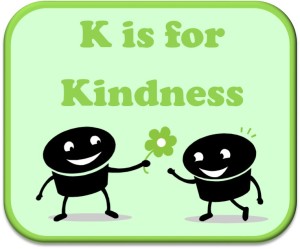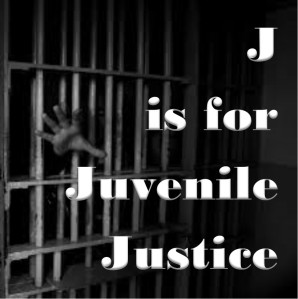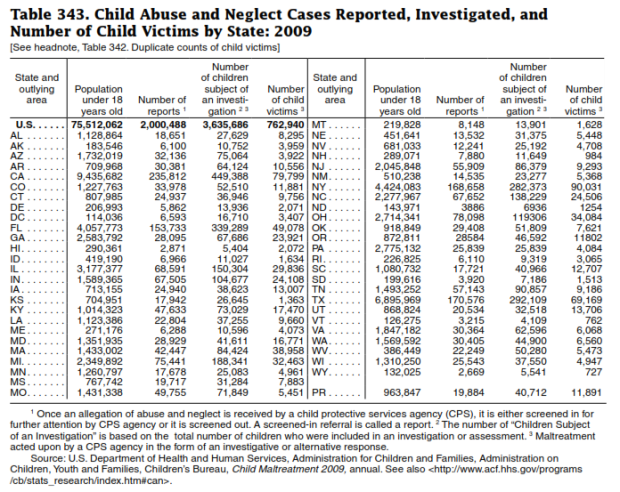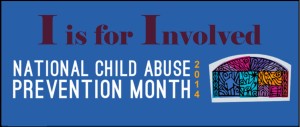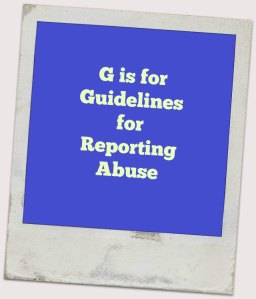The sadness and fear that lives in me as the mother of an 18 year black high school student who is oblivious to how the real world works is almost debilitating.
K is for Kindness – A to Z on Child Abuse Prevention
There is no excuse for abusing and neglecting a child. Factors such as drugs and alcohol or a history of victimization of the parent/guardian substantially raise the odds of abuse in a home. But there is also a correlation between abuse and the inability or refusal to deal with the everyday stressors in life. Parents and guardians lacking the support systems and coping skills to handle the responsibilities and hard work that go into caring for and raising a baby or multiple children, regardless of their socio-economic status, can create high-risk situations for children in those homes.
Sometimes it seems like every door is closing in your face. That no one hears you or even sees you. That you are doing it all on your own and you are doing it all wrong. That you will never NOT feel like you do right now. This kind of despair in the adults of a household can breed devastating results in the home.
One small ray of sunshine. One breath of fresh air. One break in the madness. When faced with an impossible situation, one touch of hope may change your life. It could make such a difference why would you not run out your door and do one of these things Right Now?
HERE IS WHERE YOU CAN HAVE AN IMMEDIATE IMPACT ON A FAMILY IN YOUR COMMUNITY
Random Acts of Kindness that won’t cost you much time or money but to someone they could mean EVERYTHING.
- Say “Good Morning” to the person standing next to you in line or on the train.
- Pay the toll for the driver behind you.
- Write a letter and put it in the mail to someone, young or old. Remember how great it felt to get mail that wasn’t a bill or ad.
- Offer to make a grocery store run for an elderly neighbor or the lady next door who has four kids.
- Give a homeless person your left overs when you leave a restaurant. Especially if you’re pretty sure it’s going to end up in your trash or trashing your diet.
- Put a coin in a meter that has expired or getting ready to expire.
- At the grocery store, don’t let anyone put back groceries because they are a dollar short if you have a dollar to spare.
- Hold the door for a mother/father with children or pregnant woman, even if it takes a really long time.
- Look someone in the eyes and wish them a good day like you mean it.
- If you see someone struggling with their children in public it is stressful for everyone around. You don’t want to offer to help with the kids. That can be either scary or insulting. But do offer to help with the task the kids are making more difficult. Help get the stroller through the door. Give up your seat so she can put a kid there. Carry her tray to her table for her so she can hold her kids hands or push a stroller.
- Say “Please” and “Thank You” and “Excuse Me” like you mean it to everyone. It’s not just respectful… it’s refreshing.
- Let a car in your lane. You are now one car length further from reaching your destination but you might have just prevented some road rage.
- Offer to baby sit for a mom.
- Stop what you are doing and concentrate everything on listening to someone who needs an ear.
- Use the comment/complaint box to compliment great service you received by name.
- Offer a hug without question or advice.
- Ask “How are you really doing?” when the usual response of “fine” doesn’t seem fine at all.
- Leave a really good tip for really good service. A lot of times 15% seems like too much but sometimes it is not enough.
- If you are able, pick up the tab of a person or family when you are out eating. (Someone did this for me once when I was out with my kids who were acting like miniature hooligans. I didn’t need it but thinking of it now feels like walking in soft sunshine which isn’t even close to how wonderful it felt at the time.)
- Smile at the people you pass.
- Donate food and items directly to food banks, women’s shelters and children’s homes. Goodwill is great but they sell your items to fund their efforts. A woman in a shelter could use your never-wear suit on a job interview. That crib will never be empty at the children’s home. And the green beans your husband won’t eat will sure be tasty to a hungry family.
- Say something nice to everyone you speak to today.
- If it seems like someone could use a chance to vent (friend or stranger), create an opportunity and a space for them to do that. You don’t need to solve their problem. Just let them get it out.
- Let people in line behind you go before you if it makes sense. They have one item or are obviously in a hurry. The kids are crying or you have a circumstance you know will tie up the line for a while. Things like that could be little to you and a lifesaver for someone else.
- Leave your change in the snack or soda machine. Finding a few coins makes it seem like good things are coming your way.
J is for Juvenile Justice – A to Z on Child Abuse Prevention
Many studies have been done showing that child abuse can lead to many unfortunate outcomes later in life. In “F is for Facts” you saw that children who experience child abuse and neglect are 9 times more likely to become involved in criminal activity. These startling numbers show once again that child abuse affects everyone. It is a human race problem when the actions of abusive and neglectful family life create a traumatic environment that is insufficient for proper mental, physical and social growth.
Being abused or neglected as a child increases the likelihood of arrest as a juvenile by 59%, as an adult by 28%, and for a violent crime by 30% according to a study published in 2001 titled “An Update on the ‘Cycle of Violence’”. We have an huge justice system in this country and we also have a very extensive child protection system but they do not always work together and when a victim falls through the cracks of the protection system they often end up in our jails, further victimized and removed from the help they need to recover.
This graphic from the US Census shows the reported child abuse numbers by state, giving you an idea of the impact in your area if you do the math of how many of these children are going to end up committing a crime.
There is a way to make the system work better. Some cities are instituting some smart processes that could make an impact but many are not. I invite you to view this short video on Innovations in the Juvenile Justice System and think about what can be done to in your area to help victims not become part of the system.
I is for Involved – A to Z on Child Abuse Prevention
You’ve heard the stories. You’ve seen the statistics. The chances are pretty good that child abuse has touched your world if not personally then with someone you know in your family or community. We all know its wrong, and it must stop.
So what do you do? How can you get involved in the fight against child abuse?
A is for Advocacy of this Blogging Series discussed a few of the many ways you can contribute to the fight against child abuse by speaking out and educating people. Here are some suggestions on additional ways to get involved.
The Short List to Getting Involved
Get to know your neighbors. Problems seem less overwhelming when support is nearby.
Help a family under stress. Offer to babysit, help with chores and errands, or suggest resources in the community that can help.
Reach out to children in your community. A smile or a word of encouragement can mean a lot to a child, whether from a parent or passing stranger.
Be an active community member. Lend a hand at local schools, community or faith-based organizations, children’s hospitals, social service agencies, or other places where families and children are supported.
Keep your neighborhood safe. Start a neighborhood watch or plan a local ‘night out’ community event. You will get to know your neighbors while helping to keep your neighborhood and children safe.
Promote child well-being in your personal life by being very conscious of your daily involvement and interaction with your family and other families. 30 Ways to Promote Child Well Being Child Welfare.gov provides a bunch of great little tips in this calendar: CAP Parent Engagement Calendar
When you are ready to make a real commitment to getting involve you could:
- Register to vote and get to know your elected officials. Taking an active role in the election process helps get policy-makers who are passionate about what you are passionate about in office and in a position to make changes that give more protection to children and victims. Be the voice of silent victims and communicate your concerns to your local city council, state legislators and federal Congresspersons. Meet face to face, write your policy-makers, and call your elected officials.
- Use your influence to get the word out that there is a problem that needs to be addressed at a local and national level. Even if your circle of influence is five Twitter followers from India and a Facebook friends list of eight that includes your mom and five brothers you are still and influencer of people. You can speak to your professional associations, service clubs or religious institutions. Don’t spam people in person or online, simply get the word out about events, tell your personal story, engage in dialogue and get feedback on what other people are thinking and feeling. This educates the masses and can create partnerships that can affect change.
- Become a volunteer or a leader. There are literally thousands of organizations that could use your help in their programs. The previous post “Giving Safely – an A to Z Bonus” details ways you can check if organizations you are interested in are legitimate. If you are unaware of the organizations in your community you could volunteer I’d like to make a suggestion. Simply go the search bar of your favorite internet home page and Yahoo, Google, or Bing “Child Abuse [your city]”. You’ll likely get some local news you were unaware of but you will also get a list of organizations in your area. You can also call 2-1-1 to find out about organizations that support families in your area. Do some research, check their background if anything seems off and find a few hours in your month that you can stop what you are doing and help the children in your community. Working with children and for a cause can be extremely rewarding and gratifying. Even if it is stuffing envelopes or making phone calls, all levels of volunteerism DO help.
Take a moment to think about what you could do towards the prevention of child abuse and how you could help victims. And then take the MOST IMPORTANT STEP and do something. Taking action makes a difference.
H is for Healing – A to Z on Child Abuse Prevention
I set up to write a post on the healing process for children of sexual child abuse specifically because of the added stigmas surround abuse of a sexual nature. In doing my research I found a great website that addressed it better than I could after hours of research.
I’d like to thank the Advocacy Center for this great information on the subject of healing and encourage you to click the link and read the Advocacy Center side bar to explore more information like “Reducing Children’s Vulnerability to Sexual Abuse” and “Who Sexually Abuses Children”.
The Advocacy Center
Beginning to Heal from Child Sexual Abuse
It may be very difficult for a survivor of child sexual abuse to talk about what happened to them. Many survivors cannot or do not talk about the abuse right away, and sometimes they can’t even remember about the abuse until they are adults.
Some adult survivors think that because the abuse happened when they were a child that it is too late to begin talking about what happened and to heal. This is not true! It is never too late to begin to heal.
How will being abused as a child impact people as adults?
Abuses impacts different people in different ways, and there may be some survivors who feel little impact in their adult lives. Other people may experience some negative impacts, such as generalized anxiety or fear, depression, difficulty with intimate relationships, difficulty trusting themselves or others and an increased risk for using drugs or alcohol.
Each person does things to cope in their own way, and each person does what they need to in order to survive the abuse.
What does the healing process look like?
Every person responds to trauma in a different way, and there is no one “right” way to heal. A person may experience some of the following stages and emotions, and others may not.
- Recognizing that healing is possible. Survivors of abuse are not alone, it is never too late to talk about the abuse or ask for help.
- The decision to heal. The decision to heal from child sexual abuse is a powerful and positive choice. It is a commitment to a journey, and for some it may take longer than they expected.
- The Emergency Stage. During this stage, the abuse may be all that the survivor can think about and it may feel as though their life is constantly in crisis. This stage may feel very uncomfortable, but it is important that the survivors knows that it will come to an end.
- Remembering. Some people may have always had memories of the abuse, but for others they may have tried to minimize or stuff it away and forget about the abuse.
- Believing the abuse happened. As children, we sometimes deny that bad or scary things are happening because they are too hard to deal with or understand. As adults, it can still be hard to face the reality of the abuse and to recognize the different ways it has impacted us.
- Breaking the silence. Speaking out about the abuse can be a very powerful step for survivors, and one that takes a great deal of courage. Some choose to tell a counselor, some a family member or partner and others choose to speak out at a public event.
- Understanding that the abuse is not their fault. Abuse is never the fault of the person being abused.
- Connecting to the child within. It is important for the survivor to connect to the child that was hurt by the abuse, and to confront that pain and their fears.
- Grieving. Grief is a natural part of the healing process. The survivor may grieve for the ways they were hurt, for not being protected or for missing out on their childhood.
- Anger. This is another natural response to abuse, but it is important that the survivor does not turn all of the anger inward toward themselves. When addressed, anger can help guide people toward positive change.
- Forgiveness? Some people may want to forgive their abuser, but for others this is not a part of the healing process at all.
- Spirituality. For some survivors spirituality can be a source of comfort, inspiration, courage, love and strength during the healing process.
- The process of change. Survivors are faced with many changes during the healing process, and it can bring about a range of emotions. It is important that the survivor be kind and take care of themselves during this process.
- Resolution and moving on. The healing process can be a long one, but there will come a point where the survivor feels like their life is more balanced and that they are no longer in constant crisis. It is important for survivors to remember that there is no finish line to healing, they will have some good days and some hard days but the hard days will come less and less.
G is for Guidelines for Reporting Abuse – A to Z on Child Abuse
Child abuse is an ugly subject. Even people who dedicate their lives to helping children want to block out the visions, sounds and memories that echo in the aftermath of meeting victims of abuse. So what are you to do when you suspect something might be happening but not knowing how you could help, feel powerless to help a child suffering under the monster that is child abuse?
Today you can arm yourself with the knowledge that you can protect a child, and help an entire family, by properly reporting the suspected or obvious mistreatment of a child. Anyone can report suspected child abuse or neglect. You could save a life.
Identifying Child Abuse
Child abuse is defined as any intentional, emotional, physical or sexual injury to a child. These abuses can take many, many forms. Laws and levels of intervention differ from state to state but here is a very generalize list of identifiers of child abuse.
PHYSICAL ABUSE
Bruises, such as those caused by hands, fists, electrical cords, clothes hangers, and belts | Internal organ injury which can be difficult to detect but may lead to internal bleeding | Bone fractures, especially arms, legs, and skull | Burns from such things as cigarettes, lighters, and stove burners | Lacerations caused by knives, razor blades, or other sharp objects
SEXUAL ABUSE
Inappropriate sexual touching | Fondling | Rape | Prostitution | Pornography | Forcing a child to perform or help to perform any sexual behavior
EMOTIONAL ABUSE
Constant belittling, shaming and humiliation | Frequent yelling, threatening or bullying
NEGLECT
Physical neglect involves a spectrum of behavior ranging from refusing to provide basic nutrition or necessary health care for the child to total abandonment of the child | Emotional neglect has a wide spectrum of behavior starting with the absence of adequate adult affection toward the child and includes exposing the child to physical violence and/or arguing/fighting between parents | Educational neglect occurs when the child’s caretakers fail to provide the child with an adequate educational experience
Reporting Child Abuse
Childhelp® is a national organization that provides crisis assistance and other counseling and referral services. Not only for victims, Childhelp can connect those who want to report abuse to the correct resources.
The Childhelp National Child Abuse Hotline is staffed 24 hours a day, 7 days a week, with professional crisis counselors who have access to a database of 55,000 emergency, social service, and support resources. All calls are anonymous. Contact them at 1.800.4.A.CHILD (1.800.422.4453).
If you witness child abuse or neglect contact your local law enforcement agency so a professional can intervene immediately. If you suspect child abuse or neglect or have witnessed a situation you find concerning you can refer to this list of State Child Abuse Reporting Phone Numbers to get more localized assistance in finding your next step.
Note that in some states any person who suspects child abuse or neglect is required to report it. You can check your states standings on Mandatory Reporting of Child Abuse and Neglect online in the linked pdf.
F is for Facts – A to Z on Child Abuse Prevention
Children are abused on an epidemic level worldwide and sadly America’s numbers are gruesomely high for a nation know as a world leader. I’ll give you the cold hard facts here and encourage you not to simply take my word for but to further educate yourself (AND OTHERS) using the sources links at the bottom of this post.
Note: Because national and state agencies collect and analyze their data in different ways, statistics will vary. Taking into account the under-reporting of abuse we can assume that these numbers would higher and NOT lower if all variables were removed.
THANK YOU FOR CARING!
THE FACTS:
-
Every year 6 million children will be part of a child abuse report.
-
About 30% of abused and neglected children will later abuse their own children.
-
Approximately 70% of children that die from abuse are under the age of 4.
-
Children who experience child abuse and neglect are 9 times more likely to become involved in criminal activity.
-
More than 90% of juvenile sexual abuse victims know their perpetrator in some way.
-
Child abuse occurs at every socioeconomic level, across ethnic and cultural lines, within all religions and at all levels of education.
-
In one study, about 80% of 21 year olds that were abused as children met the criteria for at least one psychological disorder.
-
14% of men and 36% of women in prison were abused as children – twice the frequency of the general population.
-
Abused children are 25% more likely to experience teen pregnancy and more likely to engage in sexually risky behavior.
-
Parents who abuse alcohol and drugs are three times more likely to abuse their children and four times more likely to neglect them.
-
As many as two-thirds of the people in treatment for drug abuse reported being abuse or neglected as children.
-
Adolescents with a report of abuse or neglect are three times more likely to have a substance abuse disorder before they are 18 years old.
Sources:
- U.S. Department of Health and Human Services, Administration for Children and Families, Administration on Children, Youth and Families, Children’s Bureau. (2013). Child Maltreatment 2012. Available from http://www.acf.hhs.gov/programs/cb/research-data-technology/statistics-research/child-maltreatment
- United States Government Accountability Office, 2011. Child maltreatment: strengthening national data on child fatalities could aid in prevention (GAO-11-599). Retrieved from http://www.gao.gov/new.items/d11599.pdf
- U.S. Department of Health and Human Services Administration for Children and Families Administration on Children, Youth and Families Children’s Bureau.Child Abuse and Neglect Fatalities 2011: Statistics and Interventions. Retrieved from http://www.childwelfare.gov/pubs/factsheets/fatality.pdf
- Snyder, Howard, N. (2000, July). Sexual assault of young children as reported to law enforcement: victim, incident, and offender characteristics. Retrieved from http://bjs.ojp.usdoj.gov/content/pub/pdf/saycrle.pdf
- Long – Term Consequences of Child Abuse and Neglect. Child Welfare Information Gateway.Washington, D.C.: U.S. Department of Health and Human Services, 2013. Retrieved from http://www.childwelfare.gov/pubs/factsheets/long_term_consequences.cfm
- Fang, X., et al. The economic burden of child maltreatment in the United States and implications for prevention. Child Abuse & Neglect (2012), doi:10.1016/j.chiabu.2011.10.006 Retrieved from: http://www.sciencedirect.com/science/article/pii/S0145213411003140
- Harlow, C. U.S. Department of Justice, Office of Justice Programs. (1999).Prior abuse reported by inmates and probationers (NCJ 172879) Retrieved from http://bjs.ojp.usdoj.gov/content/pub/pdf/parip.pdf
- National Council on Child Abuse and Family Violence. Parental Substance Abuse A Major Factor In Child Abuse And Neglect. Retrieved from http://www.nccafv.org/parentalsubstanceabuse.htm
- Swan, N. (1998). Exploring the role of child abuse on later drug abuse: Researchers face broad gaps in information. NIDA Notes, 13(2). Retrieved from the National Institute on Drug Abuse website: www.nida.nih.gov/NIDA_Notes/NNVol13N2/exploring.html
- Every Child Matters Education Fund. (2012). We can do better: Child abuse deaths in America (3rd ed.). Retrieved from http://www.everychildmatters.org/storage/documents/pdf/reports/can_report_august2012_final.pdf
- Office on Child Abuse and Neglect, Children’s Bureau. Goldman, J., Salus, M. K., Wolcott, D., Kennedy, K. Y. (2003) A Coordinated Response to Child Abuse and Neglect: The Foundation for Practice, Chapter 5, retrieved from: https://www.childwelfare.gov/pubs/usermanuals/foundation/foundatione.cfm
- Wilson, E., Dolan, M., Smith, K., Casanueva, C., & Ringeisen, H. (2012). NSCAW Child Well-Being Spotlight: Adolescents with a History of Maltreatment Have Unique Service Needs That May Affect Their Transition to Adulthood. OPRE Report #2012-49, Washington, DC: Office of Planning, Research and Evaluation, Administration for Children and Families, U.S. Department of Health and Human Services. Retrieved from: http://www.acf.hhs.gov/sites/default/files/opre/youth_spotlight_v7.pdf
- Amy B. Silverman, Helen Z. Reinherz, Rose M. Giaconia, The long-term sequelae of child and adolescent abuse: A longitudinal community study, Child Abuse & Neglect, Volume 20, Issue 8, August 1996, Pages 709-723. retrieved from: http://www.sciencedirect.com/science/article/pii/0145213496000592

E is for Education – A to Z on Child Abuse Prevention
From the website of:
THE NATIONAL CHILDREN’S ALLIANCE
Empowering local communities to serve child victims of abuse.
Knowledge is our strongest weapon.
In the fight against child abuse, knowledge is our strongest weapon. The more you know about it, the more you can do to help those who have already been victimized and to prevent it from happening again. NCA encourages you to learn more about child abuse and the programs in your community and to pass that information on to those around you.
Start with your own family and your own community. Help teach children about safety and raise awareness in your community about child abuse. Learn more about internet safety, and pass this knowledge on. And volunteer your time – no gift to your community is more valuable than that.
Safety Education and Child Abuse Awareness
Darkness to Light
Child Help USA
National Center for Missing & Exploited Children
Giving Safely – an A to Z Bonus
When giving from the heart or from the wallet you want to trust that the organization you are giving to is legitimate and using the money in a manner you support. Your good deed should not end up involving you in a scam or under-performing association.
Here is a quick list of websites you can use to get the facts behind your nonprofit of choice – especially if the organization has approached or solicited you personally for a donation.
1. The IRS has a search option for IRS exempt status charities. Charities must register with the IRS for your donations to be tax deductible so consider this when donating money. There are some very small, local charities that do not enjoy tax-exempt status and there would be more risk involved in giving.
2. GuideStar.org was the go-to resource for verifying a nonprofits status when I worked in corporate gifting. Over a million charities are listed and have met IRS criteria for exempt status.
3. Charity Navigator is a great tool when you want to compare nonprofits as it ranks charities based on their efficiency, transperancy and accountability on a four star system.
4. The Better Business Bureau Giving Alliance gives information about charities and publishes a quarterly guide on wise giving as well as issues alerts on scams. Vetted charities are given the BBB seal to display online and in print. You can scroll through the A to Z index or search by category or name.
If you feel you may have encountered a scam:
Contact your state attorney general’s office (National Association of Attorneys General listing) as they are responsible for investigating fraud such as nonprofit scam.
Additionally, if you feel you may have been solicited by a fraud nonprofit you can file a complaint with the Federal Trade Commission online or by calling 1-877-FTC-HELP. This website is a comprehensive resource on charity scams.
Precautions with phone and email solicitations:
Many scams are run through telephone solicitations and we have all seen the spam emails so what can you do to protect yourself from fraud? If the organization sounds like something you would like to give to then request printed materials from the organization. NEVER give your credit card or banking information to an organization who called you – do your research and contact them back. If something sounds off, trust that instinct and check your resources to verify the organization and report suspicious solicitations.
Make no mistake that I believe that donations are a vital part of the continuing the fight against child abuse. I just want you to see your donation go to actually helping the kids and to protect yourself from the small minority of scam artist who prey on good hearted givers.

